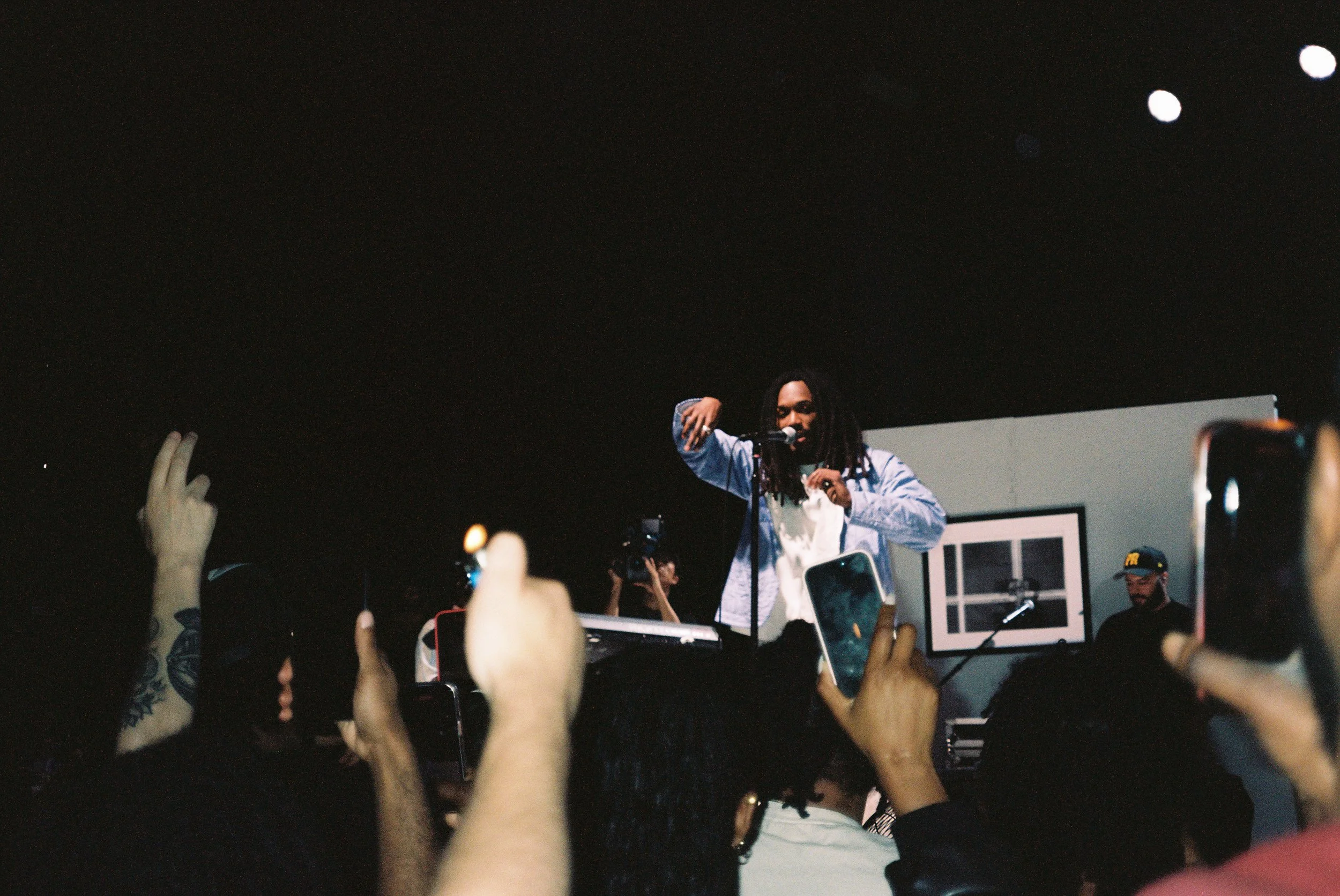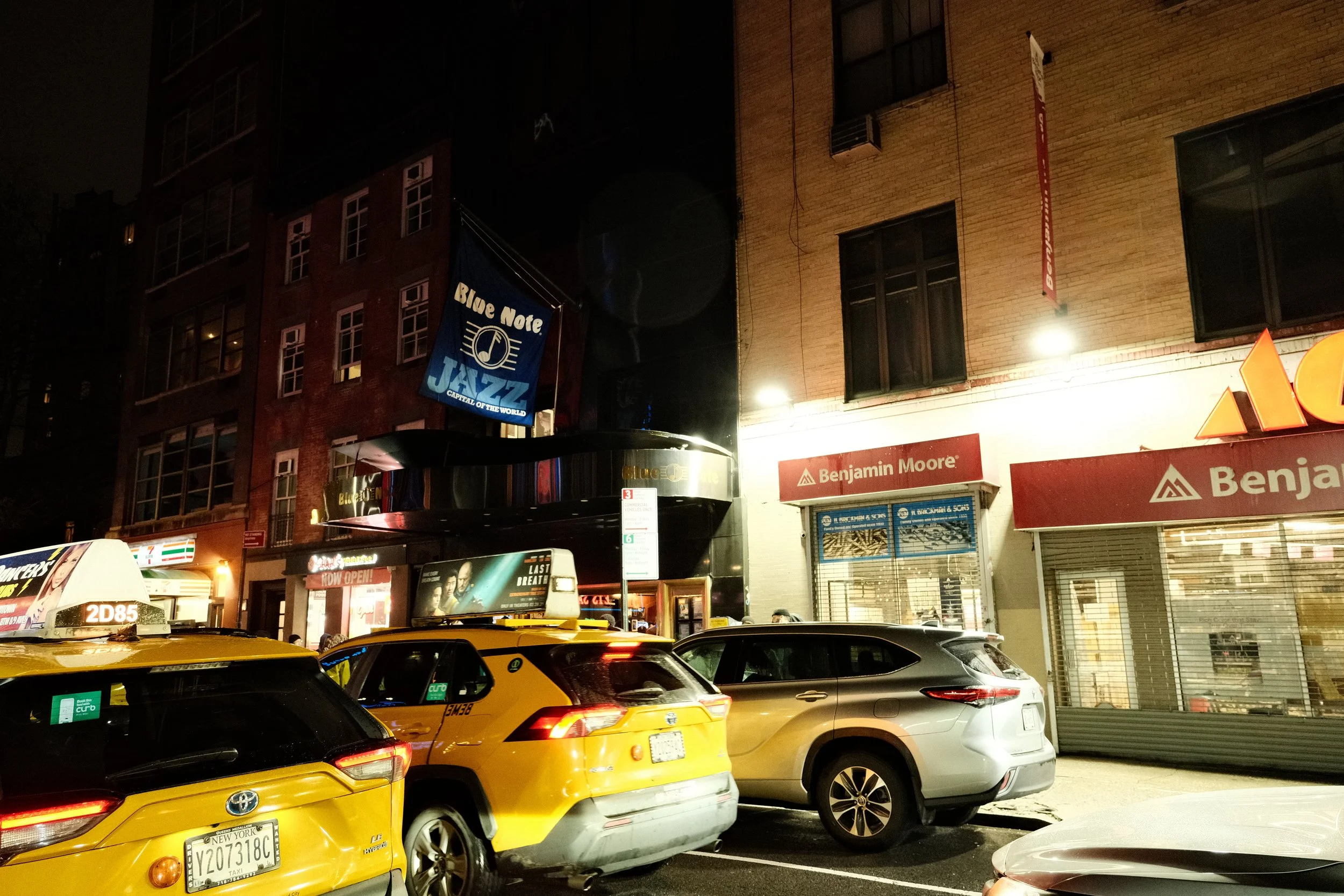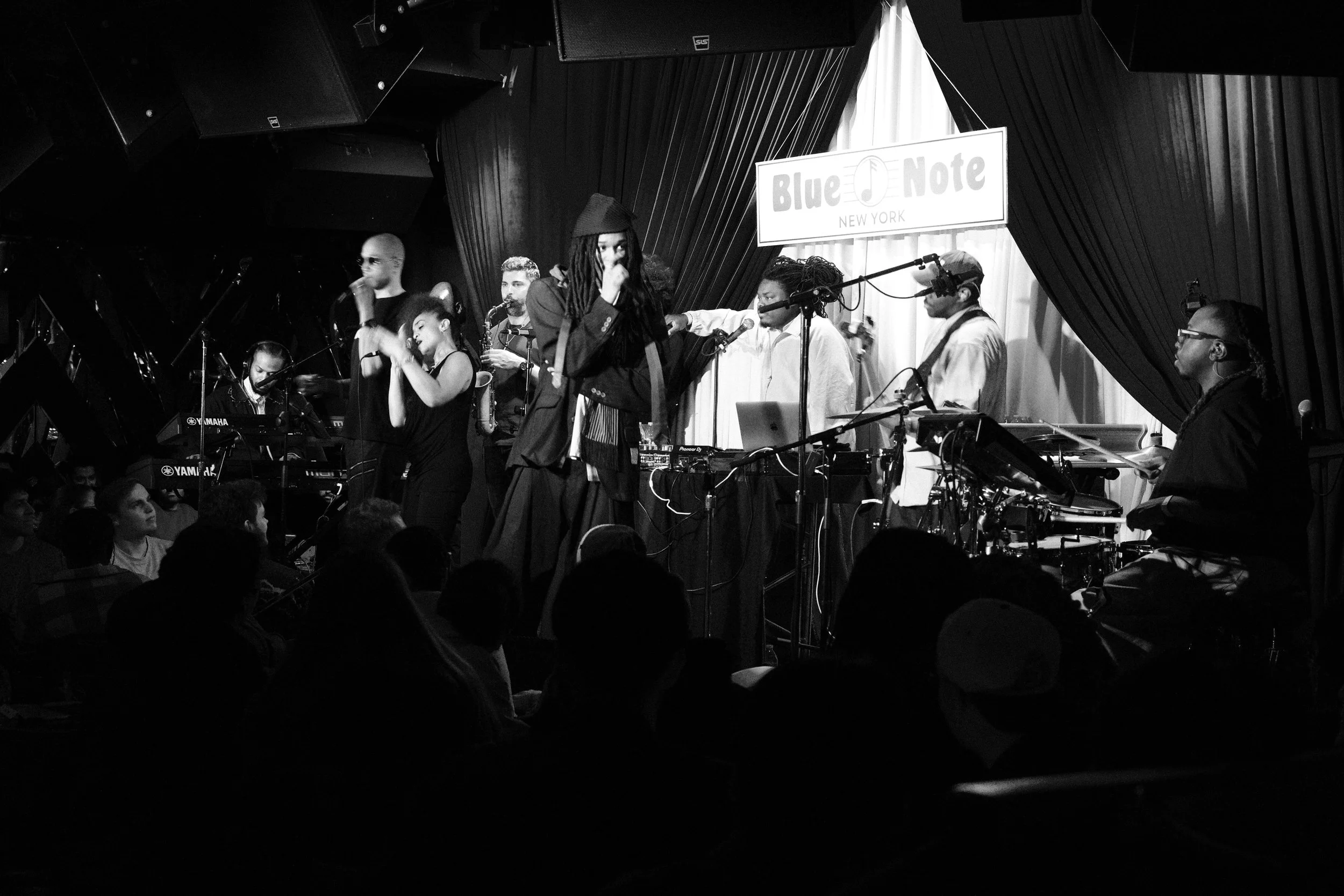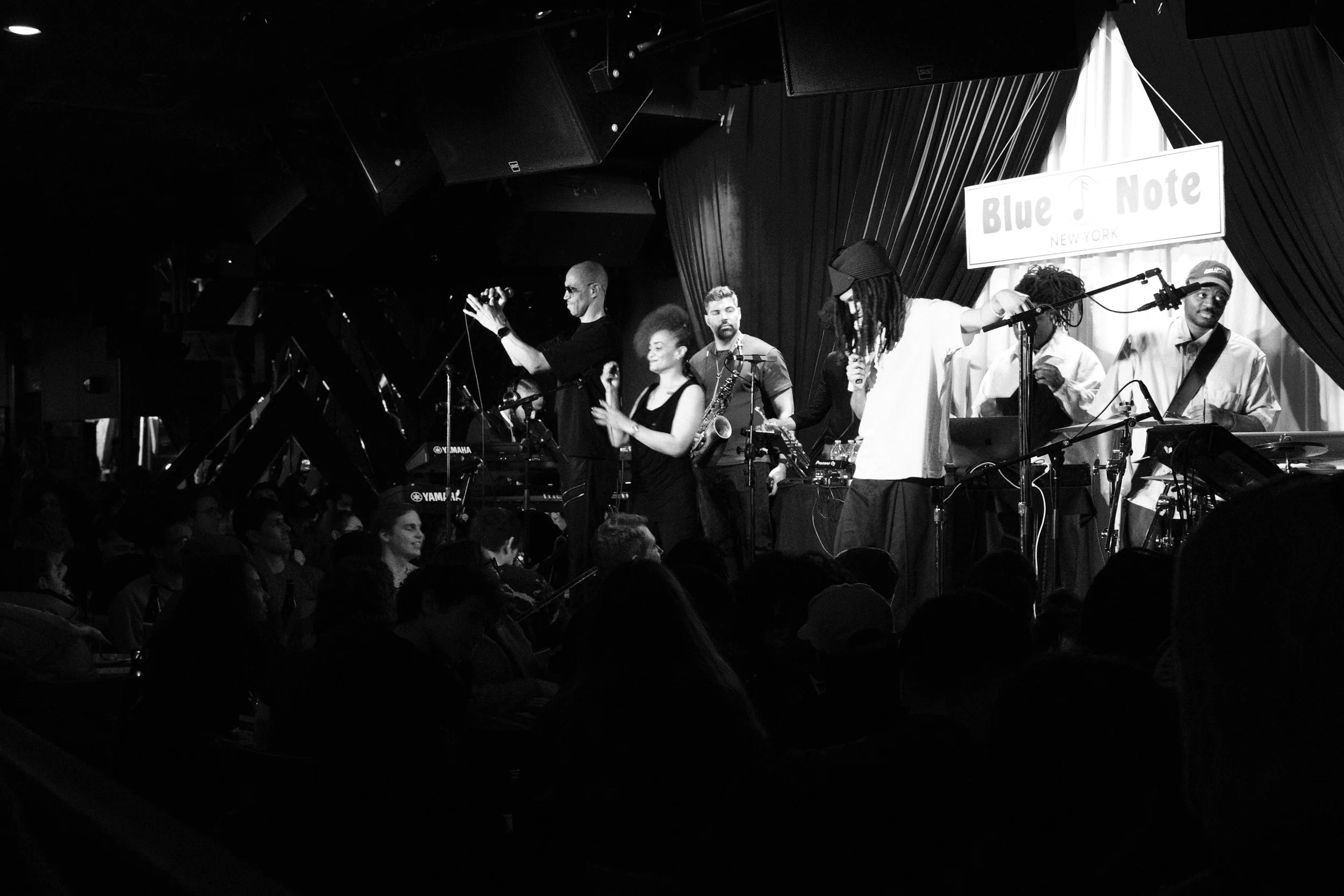Saba’s View of Place: A Review of Performances at The Blue Note and The Big Picture Tour
June 28, 2025
Photography by Stanley Collins
On March 18th, Saba — the Chicago-born independent rapper and producer — released his 5th studio album, From the Private Collection of Saba and No I.D., a collaborative project with veteran producer, No I.D. Following the releasing of the album, Saba performed series of shows at New York’s Blue Note jazz club, then ventured on The Big Picture Tour, a multi-city US tour.
Kevin and I got the chance to see Saba in New York City at The Blue Note, then again in Philadelphia for The Big Picture tour. In our review, we talk about how we came to Saba’s music and what his music does for us; we talk about each show, how they differed and resembled at different points, and more. Here’s our conversation:
Stanley: To give folks somewhat of an entry point, how did you come to Saba and his music? What does his music do for you, if anything?
Kevin: I’m excited to get these words out! Saba has been one of my favorite artists for a minute. I first experienced his music randomly, actually, 10 years ago (just did some quick Googles to confirm). I went to see Mick Jenkins at The Barbary in 2015 and Saba was on the undercard along with Noname (before she dropped the “gypsy” from her name). But I remember leaving the show most impressed with Saba. Went to look up his music on SoundCloud and listened to ComfortZone. I became a fan that night. Gladly took my seat on the bandwagon.
My favorite thing about Saba’s music is how relatable and honest it is. He can always paint a picture of a seemingly nondescript thing, like on his latest feature on the new Bas and The Hics album. He says, “certain things I can’t explain, you just had to see it, the grocery store was Save-A-Lot across from the Walgreens.”
Saba’s ability to talk about place in so many big and small ways is important to me. He loves his hometown (Chicago) — it is also the cover art for this latest album — and his discography is essentially a deep dive on how place shaped him and continues to even though he doesn’t live there anymore. Pretty sure he is an LA bol now.
The reason why I bring this up is because this is what I feel most when I listen to Saba’s music. His willingness to tell us how a place can be all things. A place of joy. Fear. Love. Creativity. And where grief happens. Like, deep grief. He mentions on the opening track, Every Painting has a Price, that for him, “it’s crazy how many stories people claim that you voicing.”
For me, being able to be a full human is important. Feel things. Talk about things that matter. Reflect on life and be present with yourself. That’s Saba to me. He is going to make it sound good, too, which is also important, but his willingness to dig deep into his own experiences makes the listener look at their own lives a bit more deeply.
I wasn't fully locked in on Saba yet, so I'm pretty sure you sent me Saba's 2016 album, Bucket List Project. Man, from the first song — In Loving Memory — I was completely blown away. - Stanley
Saba always has a reflection, observation or something that makes me think. He is an artist that makes me want to do better. It’s crazy to say all of these things about someone I will never meet, for real. But that’s why it’s not crazy to me that others feel connected to Saba. He is voicing the human experience. And his experience is one of self-exploration and a commitment to that process.
I rambled. Gmail let you send messages this long? But what you think. I know you a Saba fan clearly but I’m not sure I’ve heard you articulate what Saba’s music does for you.
Stanley: I love what you're saying about the role of place in Saba's music; how vivid his songwriting is. That's something I appreciate, too. I feel a kinship with the West Side of Chicago because of him lol.
I came to Saba's music through you. I wasn't living in Philly when that show at The Barbary happened, so I missed it (I was living in Stillwater, OK for grad school at the time — needless to say, Saba and co. did not come to my campus lol). Around this time — 2014/2015 — I'd been listening to Mick Jenkins for a few years, and he and Saba were running in the same circles. So, I'd heard him as a feature on Mick Jenkins' song Slumber from his Wave[s] album in 2015.
Still, I wasn't fully locked in on Saba yet, so I'm pretty sure you sent me Saba's 2016 album, Bucket List Project. Man, from the first song — In Loving Memory — I was completely blown away. The song starts with the sound of somebody opening a car door and starting it. It's a slow burner of a tune that builds with each passing measure. A, a muted trumpet, and acoustic guitar open the track, then the bass and drums come in on the hook. And Saba is RAPPING, so much so that he starts coughing as if he's out of breath. Lyrically, the song is like a crazy run-on sentence because he's saying so much. That project painted such a vivid picture of his life to that point and the people around him (he had folks submit "voice notes" on their bucket list items that he incorporated as interludes). I think this song is a great example of what has drawn me to his music.
I love that [The Blue Note] gave Saba space to perform the new stuff. Allow him and the fans to get familiar with the new material - Kevin
Saba talks about how he comes from a long line of musicians, and you can hear it. He produces a lot of his own music, and his music is really interesting and exciting harmonically. The live instrumentation is a huge plus that raises each song, too. The sonic palette he pulls from is vast and intricate.
Most of all, what draws me to Saba's music is that the storytelling is true to him, the interiority of his music — he's not putting on a mask. I think about what you wrote for his album CARE FOR ME — which largely deals with the death of his cousin who was murdered — and about the grief that that event caused. You wrote: "Saba is telling his truth, but he’s not asking the listener to feel sorry for him; he is transparent enough to let us into his headspace where he is questioning God, but also states that he isn’t mad at God." That type of honesty in his music does a lot for me as a listener in bringing me into his world.
We saw Saba in April as part of his run of shows at The Blue Note in NYC. After the show, you suggested that we review that show alongside his Philly show, given we knew he'd be going on tour shortly after.
What did you think of Saba's performance, his live show? How do you think it compares to the Blue Note show?
Kevin: Yeah so it was a thought that came to me because Saba hinted online somewhere while prepping for the Blue Note show that he was going to play the song GREY from his album CARE FOR ME. And that is one of my favorite songs from him. But at the blue note show he didn’t perform it. So I made a guess that he would probably do it during the tour. And I began to wonder what other songs might he do on tour from his discography that we don’t normally get to hear live. I’m glad we waited, as I have a few takes.
The Blue Note show was intimate. No surprises there. I really enjoyed hearing him speak about the creative process behind the songs from his new project, From The Private Collection of Saba and No ID. A lot of times artists may feel the pressure to perform the familiar old tracks because that is what fans do (i.e. “play the hits”). But at The Blue Note, I love that it gave Saba space to perform the new stuff. Allow him and the fans to get familiar with the new material.
Saba also talked about this somewhat at both shows. The idea that fans expect him to make the same music he did when he was 17. He is 30 now. Do we let artists try things - or do we want the hits. I like when artists push on the listener. Push us to drop expectations and go on the journey with them.
But at the tour stop in Philly - his vision really came to life in my opinion. The stage design was beautiful. It was so bright. When he was performing HEAVEN ALL AROUND ME it looked like he was on clouds, for real. But the tour stop allowed him to be artsy fartsy like he mentions “Reciprocity.” He also played to the crowd with older hits. And he played one of my favorite tracks “Ziplock” which I did not think he would do. It was a well-rounded show and the venue, though not sold out, was pretty packed. Saba still has juice. We’ve seen him perform at many venues in Philly (some that aren’t even around anymore) with this being the biggest.
I’m on the bandwagon until the wheels fall off. Saba cares too much about music. Cares about his own interiority in a way that is refreshing to hear.
What you think about both shows though? Did you prefer one over the other?
Stanley: "Intimate" is a good word to describe the Blue Note show and not just because The Blue Note is tight on space. His show felt like VH1 Storytellers to me. The stories he told in between songs added color to the music. Hearing about how Raphael Saadiq, Greg Phillinganes, and Kelly Rowland ended up on Crash, or how he got Janet Jackson to clear I Get So Lonely to be sampled on Breakdown, was cool. He also had his dad, Chandlar, singing background at the Blue Note show, which was special, as well as a 2-piece horn section.
While I really enjoyed the Blue Note show, I did leave wishing the he and the band stretched out a bit more. Saba's a gifted songwriter and vocalist and his music is incredibly rich, harmonically and melodically. I would've loved to see more moments for improvisation -- to see the band members solo more or even him improvising over an extended groove from one of the songs on the set list. It's a small gripe, and for Hip-Hop shows I've been to, I think it's par for the course to mostly remain "true" to the recorded material.
That said, the tour stop in Philly really filled in those "gaps" for me. There was a moment where they went from Stomping straight into Stoney. THAT WAS CRAZY. The drums were super locked! Hearing GREY was special, too, because -- given the album came out in 2019, COVID, and there was no tour -- we've never got the chance to hear it live. But also, the band stretched out some toward the end of GREY, and started swinging, which I'm pretty sure my brain started melting.
I like the themes Saba's been using for this album around photography, having a "private collection." These themes came through on the stage design. The stage had three, white panels about 8 feet wide, with framed photos on them. There were spotlights posted on them from above. The stage, the show, felt like we were in a gallery. Stage design and lighting for the contemporary concert can be really expensive and gaudy — floating cars, pyrotechnics, big, LED screens, etc. — but the stripped back nature of Saba's stage design was well done and enhanced the experience for me.






